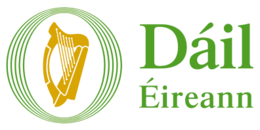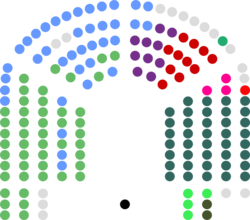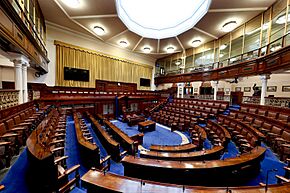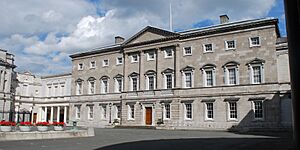Dáil Éireann facts for kids
Quick facts for kids Dáil Éireann |
|
|---|---|
| 34th Dáil | |
 |
|
| Type | |
| Type |
Lower house of the Oireachtas
|
|
Term limits
|
None |
| History | |
| Established | 29 December 1937 (Modern form) |
| Preceded by | Dáil Éireann (Irish Free State) |
| Leadership | |
|
Verona Murphy
Since 18 December 2024 |
|
|
Leas-Ceann Comhairle
|
John McGuinness, FF
Since 19 February 2025 |
|
Government Chief Whip
|
Mary Butler, FF
Since 23 January 2025 |
|
Deputy Chief Whip
|
Hildegarde Naughton, FG
Since 23 January 2025 |
| Structure | |
| Seats | 174 |
 |
|
|
Political groups
|
Government (91)
Supported by (4)
Opposition (78)
|
| Committees |
5
Business
Members' Interests of Dáil Éireann Parliamentary Privileges and Oversight (Dáil) Public Accounts Standing Orders and Dáil Reform |
|
Joint committees
|
20
Agriculture, Food and the Marine
Autism Children, Disability, Equality, Integration, and Youth Disability Matters Education, Further and Higher Education, Research, Innovation, and Science Enterprise, Trade and Employment Environment and Climate Action European Union Affairs Finance, Public Expenditure and Reform, and Taoiseach Foreign Affairs and Defence Gender Equality Implementation of the Good Friday Agreement Irish Language, Gaeltacht and the Irish-speaking Community Health Housing, Local Government and Heritage Justice Public Petitions Social Protection, Community and Rural Development and the Islands Transport and Communications Tourism, Culture, Arts, Sport and Media |
|
Length of term
|
No more than 5 years |
| Authority | Articles 16−17, Constitution of Ireland |
| Salary | €113,679 per year plus expenses |
| Elections | |
| Proportional representation (single transferable vote) | |
|
Last election
|
29 November 2024 |
|
Next election
|
By January 2030 |
| Redistricting | Advisory recommendations made by the Electoral Commission |
| Meeting place | |
 |
|
| Dáil Chamber Leinster House, Kildare Street, Dublin |
|
| Constitution | |
| Constitution of Ireland | |
Dáil Éireann (pronounced "dahl AIR-un") is like the main classroom or "lower house" of Ireland's parliament, called the Oireachtas. The Oireachtas also includes the President of Ireland and a senate called Seanad Éireann.
The Dáil has 174 members, and each one is called a Teachta Dála (pronounced "tyak-tah DAW-lah"), or simply a TD. TDs are chosen by people in different areas of Ireland, called constituencies. They are elected for up to five years using a special voting system called proportional representation with the single transferable vote (PR-STV).
The Dáil is the most powerful part of the Oireachtas. It can make almost any law it wants. It also chooses the Taoiseach (pronounced "tee-shock"), who is the head of the government. Since 1922, the Dáil has met in Leinster House in Dublin.
The Dáil we have today started when the Constitution of Ireland was adopted in 1937. But it's connected to the very first Dáil, which was set up in 1919.
Contents
How the Dáil is Made Up
The Dáil currently has 174 members, or TDs. The number of TDs changes based on Ireland's population. The rules say there should be at least one TD for every 20,000 people and no more than one for every 30,000 people.
People in Ireland vote for their TDs every five years or less. This is done using a system called proportional representation with the single transferable vote. This system helps make sure that the number of seats a political party gets in the Dáil is similar to the percentage of votes they received. Each area (constituency) elects three, four, or five TDs.
To become a TD, you must be an Irish citizen and at least 21 years old. Anyone over 18 who is an Irish or British citizen and registered to vote in Ireland can vote in Dáil elections.
The Taoiseach (Ireland's prime minister) can ask the President to end the Dáil early and call a new election. If this happens, a general election must take place within 30 days.
How Elections Work
The single transferable vote (STV) system generally gives fair results, meaning smaller parties get a chance. However, because constituencies elect only a few TDs, larger parties sometimes have a small advantage. Since the 1990s, Ireland has usually had governments made up of a few parties working together.
In this system, candidates from the same party often compete against each other. This gives voters more choice. The areas where TDs are elected (constituencies) are reviewed regularly by the Electoral Commission. This makes sure that the number of people in each constituency is fair.
Where the Dáil Meets
The Dáil chamber has seats facing each other, but the ends curve to form a half-circle. TDs from the government sit on the left side of the Ceann Comhairle (the chairperson), and the main opposition party sits on their right. The Dáil chamber used to be a lecture hall before it was changed into a parliament building.
How Long the Dáil Lasts
The Dáil cannot last longer than five years from the day it first meets after an election. This rule has been in place since 1927 and was confirmed again in 1992.
The very first Dáil was set up in 1919 as the parliament of the Irish Republic. It was a single chamber. After the Anglo-Irish Treaty in 1921, the Irish Free State was created in 1922. The Dáil then became the "lower house" of a new two-chamber parliament.
When the new Constitution of Ireland was adopted in 1937, the Irish Free State became the modern state of Ireland. The parliament kept the name Oireachtas, and its main house remained Dáil Éireann.
During the COVID-19 pandemic, the Dáil met in the Convention Centre Dublin for a while to allow for social distancing. It returned to Leinster House in September 2021.
How the Dáil is Ended
When the Dáil is dissolved (ended), a new election must happen within 30 days. The newly elected Dáil must then meet within 30 days after the election. This means there's a maximum of 60 days between the old Dáil ending and the new one starting.
The Taoiseach decides when to ask the President to dissolve the Dáil and call an election. Once the President agrees, a special announcement is made. The Minister for Housing, Local Government and Heritage then sets the exact date and time for voting.
What Does the Name Mean?
The name Dáil Éireann comes from the Irish language. It is the official name of the body in both English and Irish, even in the Irish constitution.
The word dáil means "meeting." So, Dáil Éireann means "Assembly of Ireland." You usually say "the Dáil" but not "the Dáil Éireann." When talking about different Dáil elections, like the First and Second Dáils, the plural "Dáils" is used.
The Ceann Comhairle
The Ceann Comhairle is the chairperson of the Dáil. They are chosen from among the TDs and must be completely fair. To help them stay neutral, a Ceann Comhairle who is already in the job doesn't have to run for election again in their constituency. They are automatically re-elected unless they decide to retire. The Ceann Comhairle only votes if there is a tie. The current Ceann Comhairle is independent TD Verona Murphy.
What Powers Does the Dáil Have?
The Dáil is the most powerful part of Ireland's government. While the President of Ireland and Seanad Éireann (the Senate) are also part of the Oireachtas, the Dáil has the most important jobs.
Its main powers include:
- Choosing the Taoiseach (head of government) for the President to officially appoint.
- Approving the Taoiseach's choices for government ministers.
- Approving the country's budget (how money will be spent).
- Starting new laws or changing existing ones.
- Approving international agreements (treaties).
- Approving a declaration of war.
- Starting "money bills" (laws about public money), but only if the Government recommends it.
The Dáil can also vote that it no longer trusts the government. If this happens, the Taoiseach must either ask for a new election or resign.
How the Dáil Works
The Dáil has its own rules for how debates and votes happen. TDs usually vote the way their political party tells them to. The Dáil usually meets in public.
As of 2019, the Dáil meets on Tuesdays, Wednesdays, and Thursdays when the Oireachtas is in session.
- On Tuesdays, it usually meets from 2 PM to 11 PM.
- On Wednesdays, it meets from 9:12 AM to around 11:30 PM.
- On Thursdays, it meets from 9 AM to around 8 PM.
A typical day includes asking questions to government ministers and debates on new laws. Opposition parties also get time to debate their own ideas, which are often covered by the news. Most debates and speeches are in English, but TDs can also speak in Irish.
Rules for Speaking
The Ceann Comhairle makes sure everyone follows the rules for speaking in the Dáil. It's not allowed to call another TD names or suggest they are lying. There are specific rules about what can and cannot be said during debates to keep things respectful.
Committees
The Dáil has different committees that help with its work. These committees look closely at specific topics and proposed laws.
Standing Committees
These committees deal with the day-to-day running of the Dáil:
- Committee on Administration
- Committee on Members' Interests of Dáil Éireann
- Committee on Procedure and Privileges
- Committee of Public Accounts
Select Committees
These committees focus on specific areas of government:
- Select committee on Communications, Natural Resources and Agriculture
- Select committee on Environment, Transport, Culture and the Gaeltacht
- Select committee on European Union Affairs
- Select committee on Foreign Affairs and Trade
- Select committee on Finance, Public Expenditure and Reform
- Select committee on Health and Children
- Select committee on the Implementation of the Good Friday Agreement
- Select committee on Investigations, Oversight and Petitions
- Select committee on Jobs, Social Protection and Education
- Select committee on Justice, Defence and Equality
Special Committees
Sometimes, special committees are set up for important issues, like the Special Committee on COVID-19 Response.
How Voting Works
When it's time to vote, the Ceann Comhairle first asks TDs to say Tá (Yes) or Níl (No). If TDs disagree with the Ceann Comhairle's decision, they can shout Vótáil! (Vote!) to ask for a recorded vote.
When a recorded vote is called, bells ring around Leinster House to call TDs to the chamber. TDs then have a few minutes to get to their seats. They vote by pressing a "Tá" or "Níl" button on their desks. After the vote, the results are announced. Sometimes, for very important votes, TDs might vote by walking through different lobbies (rooms) instead of using the electronic system.
History of the Dáil
Early Parliaments (Before 1919)
Before the Dáil, Ireland had a parliament from 1297 to 1800. Its main house was the House of Commons. But this parliament was ended in 1800, and Irish politicians then sat in the House of Commons of the United Kingdom in London.
The Revolutionary Dáil (1919–1922)
The Dáil we know today is linked to the First Dáil of 1919. This Dáil was formed by Irish politicians from Sinn Féin who were elected to the British Parliament in 1918. Instead of going to London, they decided to meet in Dublin and create their own Irish parliament. They wanted to set up an independent Irish Republic.
The first meeting of this Dáil happened in Dublin on January 21, 1919, at the Mansion House. This Dáil was not recognized by the British government and was later made illegal, forcing its members to meet in secret.
The Irish Free State Dáil (1922–1937)
After the Anglo-Irish Treaty was signed in 1921, the Irish Free State was created in 1922. The Dáil then became the main house of a new two-chamber parliament for the Free State. This Dáil, called the Third Dáil, and all the ones after it, have met in Leinster House.
The Modern Dáil (Since 1937)
In 1937, the new Constitution of Ireland was adopted. This created the modern state of Ireland. The parliament kept the name Oireachtas, and its main house continued to be called Dáil Éireann. The first Dáil under this new constitution was known as the Ninth Dáil.
See also
 In Spanish: Dáil Éireann para niños
In Spanish: Dáil Éireann para niños
- Bicameralism
- Dáil election results
- Elections in the Republic of Ireland
- History of the Republic of Ireland
- Politics of the Republic of Ireland
- Records of members of the Oireachtas
Images for kids



